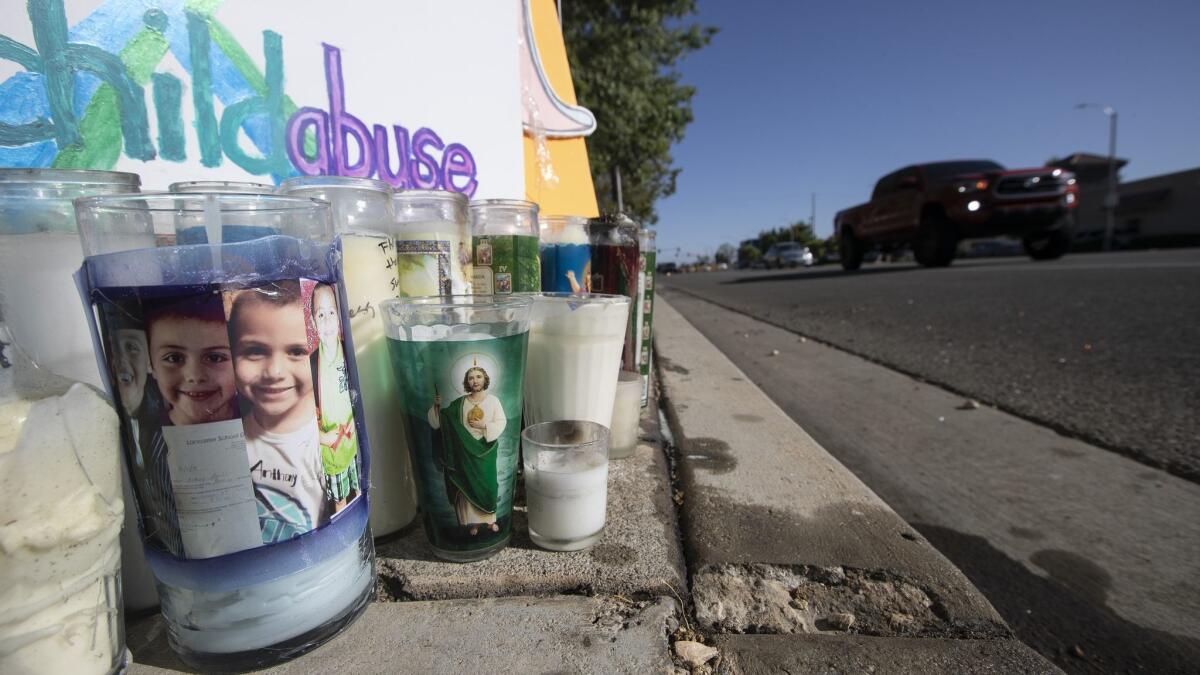County review finds abuse case of Anthony Avalos ‘very dissimilar’ to that of Gabriel Fernandez

A county review found that the Department of Children and Family Services took “considerable actions” in the case of 10-year-old Anthony Avalos, but nonetheless made a series of recommendations to minimize risks to other children in the future.
The report by Michael Nash, head of the county’s Office of Child Protection, drew a clear distinction between the child welfare system’s failings preceding the horrific death in 2013 of 8-year-old Gabriel Fernandez and how it dealt with complaints in Anthony’s case.
The boy died in June after suffering abuse. His mother and her boyfriend have been charged with murder.
“While the death of Anthony was horrible, heartbreaking, and apparently brutal; while it occurred in the Antelope Valley; and while there had been previous DCFS involvement with Anthony and his family, from a systemic perspective, this case is very dissimilar to the notorious and awful 2013 death of Gabriel Fernandez,” the report said.
In June the Board of Supervisors directed Nash’s office to review Anthony’s case history and to identify any systemic issues that got in the way of coordinating services.
The report, which will be discussed Tuesday at the Board of Supervisors meeting, described 13 contacts that Anthony’s family had with Children and Family Services between February 2013 and November 2016, after which there were no further calls to the department or to law enforcement.
The contacts included an allegation by Anthony’s mother, Heather Barron, that he was the victim of sexual abuse by his maternal grandfather, and allegations by others of neglect and abuse by Barron and her boyfriend Kareem Leiva against Anthony and his siblings.
“There were multiple DCFS investigations involving no fewer than 12 social workers (not counting supervisors),” the report said, citing frequent visits by social workers to the family home, regular interviews and physical checks of the children, “generally appropriate” use of computerized decision-making tools and cross-reporting by social workers and law enforcement.
The investigations were promoted to cases twice — once leading to participation in the “voluntary family maintenance” program, which allows children to remain at home while they and their families receive services, and once leading to a case in dependency court.
“Taking into consideration the considerable actions by DCFS … the key question is whether or not Anthony might still be alive today if certain things had been done differently. That question cannot be answered,” the report said. “What is clear is that Anthony’s death did not occur while the family was being monitored by DCFS.”
The report nonetheless made recommendations for improving department processes based on Anthony’s case history. These included revising the voluntary family maintenance program, improving the interviewing and fact-gathering skills of social workers, and increasing collaboration between law enforcement and child protection authorities on investigations.
The report also recommended reducing caseloads for social workers and supervisors. While overall caseloads in the department have declined since 2015, progress has been mixed in the Lancaster and Palmdale offices, and attrition there is among the highest in the department.
Children and Family Services will consider giving workers in the Antelope Valley assignment and retention bonuses, transportation allowances and location-based pay differentials to recruit and retain highly qualified staff there, the report said.
In addition, the report found that the High Desert Regional Health Center “medical hub,” which is charged with examining children who enter foster care and conducting forensic exams to determine abuse, is unable to meet the needs of the region. Pediatric services are available only on weekdays from 8 a.m. to 4:30 p.m., and there are no full-time physicians at the hub.
In 2017, it took 59 days, on average, to get a child an initial medical exam — well over the 30-day standard established by Children and Family Services for children older than 3, and nearly six times the 10-day standard for younger children.
The Department of Health Services, which oversees the hub, plans to expand hours and staff at the clinic, pending budgetary approval from the board.
Children and Family Services is also developing a “case quality assurance team” to review how past and ongoing cases have been handled. Work has already begun, the report said, with more than 1,000 cases selected.
Twitter: @AgrawalNina
More to Read
Sign up for Essential California
The most important California stories and recommendations in your inbox every morning.
You may occasionally receive promotional content from the Los Angeles Times.











